Passenger trains through the Channel Tunnel to and from London were inaugurated in 1994. Although high-speed trainsets were used (the 'Trans Manche Super Train' or 'TMST') running within Britain was initially rather pedestrian, being confined to existing, conventional third-rail electrified lines. I was never tempted to try out this service.
Eventually, in 2003, section 1 of the U.K's first high-speed line ('High Speed 1' or 'HS1') was opened so, having made fairly leisurely progress from Waterloo International to Fawkham Junction, a few miles beyond Swanley, Eurostar trains diverted onto the new high speed line, allowing speeds up to 186 m.p.h. I still didn't make a high-speed trip or travel through the Channel Tunnel.
However, my firm became involved with the 'TMST' trainsets when the British form of an Automatic Train Protection ('ATP') system was introduced. This APT combined the traditional Automatic Warning System ('AWS') with a new Train Protection and Warning System ('TPWS'). I helped with various elements of the design and validation of the equipment installed on the 'TMST' trainsets (by this time known, more prosaically, as 'Class 373') and, in 2005, I had the opportunity to travel on a Class 373 Test Train on the East Coast Main Line to assist with equipment testing. That trip is described here which includes a little more about the background to TPWS in the section 'The Introduction of TPWS'.
Test Train on 17th January 2006
A few months after the Grantham trip, I was able to travel on a Class 373 Test Train from Waterloo International to Paris (Gare du Nord) which travelled from Waterloo International to Fawkham Junction on conventional, third-rail electrified lines before continuing on section 1 of 'High Speed 1' through the Channel Tunnel and on to the Gare du Nord in Paris.
 Waterloo Station from the air, with the long, curving platforms used by the 'Eurostar' trainsets on the left (Photo: Network Rail).
Waterloo Station from the air, with the long, curving platforms used by the 'Eurostar' trainsets on the left (Photo: Network Rail).Click on image above for larger view.
Since test trains carried no passengers, they earned no revenue so understandably the operator, Eurostar, only reluctantly scheduled such trips. However, we had learnt that a software update for the traction control was to be tested between London and Paris on an international test train and we 'piggybacked' on this to be able to carry out further testing of the equipment we'd evaluated on the earlier trip to Grantham. We would only be able to conduct full tests between Waterloo and Fawkham Junction - beyond here on High Speed 1, in the Channel Tunnel and on the continent, the TVM cab signalling system would be in use. However, we continued to monitor our equipment in case of any anomalies.
Our equipment was set up in the equipment room just behind the front cab and we were kept pretty busy between Waterloo and Fawkham Junction checking for correct responses from the equipment which were also being saved by a recording multi-channel oscilloscope for subsequent analysis. I noticed that the cab itself was fairly full on the way from Waterloo to High Speed 1 with traction control engineers but, as we approached the Channel Tunnel, they all went back to the leading passenger coach where their test equipment was set up.
So I was able to join the friendly English driver throughout our undersea journey and a fair distance towards Paris. He apologised that he couldn't quite travel at 186 m.p.h. because one of the traction control blocks had 'tripped', reducing the top speed, but I think we were still doing around 160 - 170 m.p.h. I was surprised at what little sensation of high speed there was as we dashed through the French countryside. In high speed trains, the driving position is intentionally on the centre line of the train and the front window is surprisingly narrow, to minimise the distracting 'flicker' produced by passing Overhead Line structures and, in the tunnel itself, the frequent tunnel lighting luminaires. I'm afraid I didn't manage any photographs on the way to Paris.
In Paris, I didn't even alight from the train. We only stood for a few minutes whilst the traction engineers checked their test equipment and reset the tripped traction control block, allowing us to return at 186 m.p.h. (300 k.p.h.) where authorised. On the way back, we were in the 'back cab', which we had to ourselves. On the way back, I did manage a few pictures which are in the album Channel Tunnel and High Speed One.
Once clear of the suburbs of Paris, the line is remarkably straight across the plains of northern France and we were running at full speed.
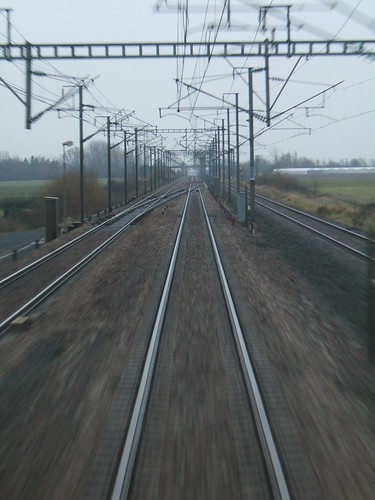
On the French High Speed Line from Paris to the Channel Tunnel.
Sooner then I anticipated, we were plunged into the Channel Tunnel (the only trouble with being in the 'back cab' is you can see where you've been, but not where you are going). I couldn't resist a picture of me 'in the chair' in the blackness of the Tunnel.
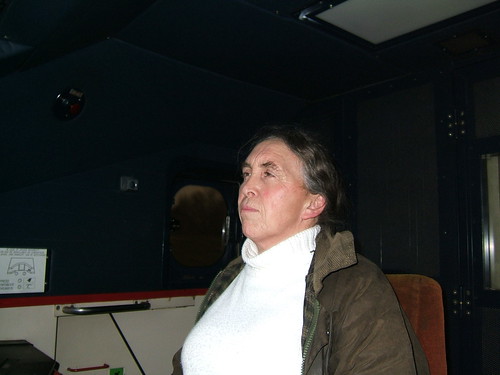
Jan in the 'Back Cab' as we speed through the Channel Tunnel returning to Waterloo.
My attempt at a "driver's view" wasn't very successful, but you can just make out tunnel lighting which is always illuminated.
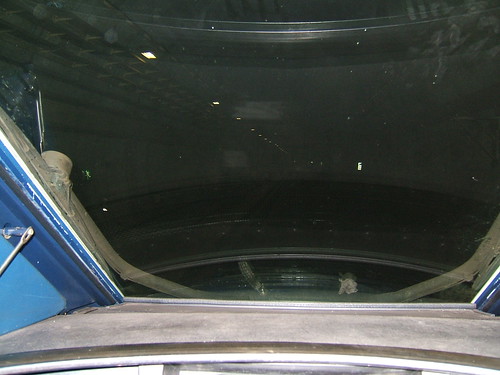
View from the 'Back Cab' passing through the Tunnel on our return to the U.K.
After 22 miles of blackness, we popped into daylight again, passing several high-speed turnouts which divert the car shuttle trains onto the their reversing loop and unloading/loading station. Tall fences flanked the high-speed line.
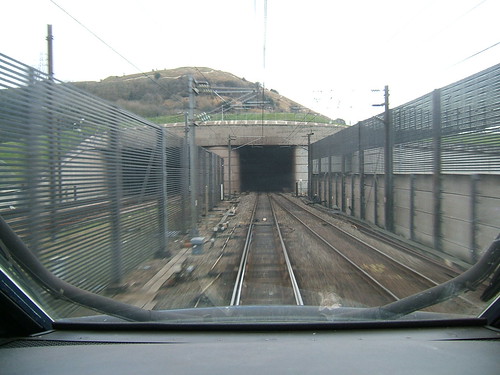
View from the 'Back Cab' emerging into the daylight in the U.K.
We were now travelling on the first section of High Speed 1 (at this date, the final section to St. Pancras International was still under construction). We by-passed Ashford International station (shared with conventional trains) by taking the concrete viaduct, allowing us to maintain our impressive speed.
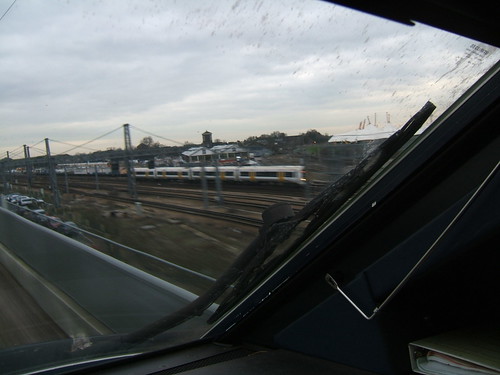
View from the 'Back Cab' as we passed Ashford on High Speed One.
At Southfleet Junction, we left the continuation of HS1 to London, still under construction, on a high-speed turnout provided with a 'swing-nose' crossing. Having decelerated, we joined the conventional third-rail electrified network at Fawkham Junction, continuing to Waterloo at a very sober pace.
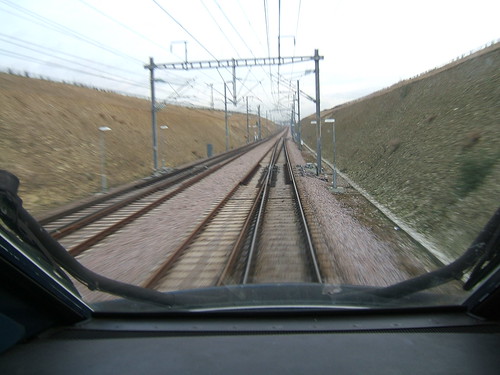
Class 373 to Waterloo: Southfleet Junction, where we left the continuation of HS1 to London.
It was dusk as we approached London Waterloo and passed a Down 'Eurostar' service.
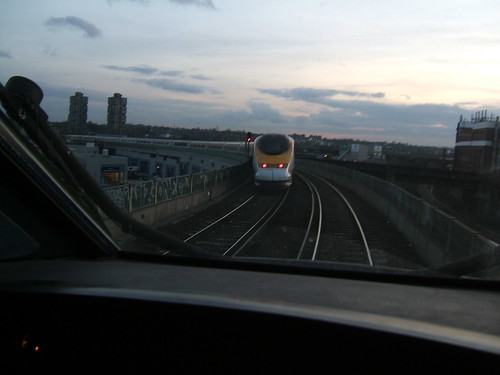
View from 'Back Cab' approaching Waterloo, having just passed a Down 'Eurostar' train.
Our train, with just a handful of engineers aboard, pulled into platform 24, next to an already well-loaded International service awaiting departure from platform 23. I'd had a fascinating trip.
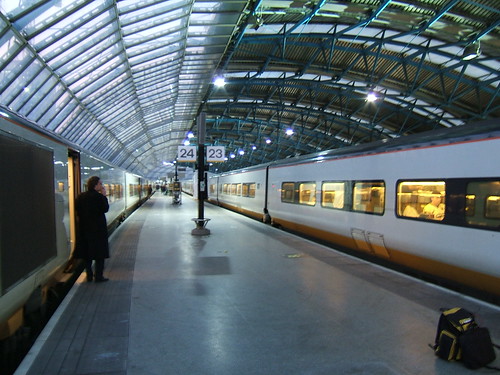
Our arrival at Waterloo International
Completion of the U.K. High Speed Route
Finally, in 2007, the complete 'HS1' was brought into use, terminating at St. Pancras International as the new London terminus and with the servicing of the high speed trainsets moved to a new depot at Temple Mills. Although I'd briefly looked at the St. Pancras terminal in 2008 (there's a post here), I still haven't made a trip on the new route to Paris, but I have been as far as Ebbsfleet International on a Class 395 trainset, as described in the post Channel Tunnel Rail Link.
References
Track diagrams showing Waterloo to Fawkham Junction, section 1 of High Speed 1 and the Channel Tunnel are shown in publication:-
‘Railway Track Diagrams Book 5: Southern and TfL’ (TRACKmaps: 3rd edition) ISBN 978-0-9549866-4-3. Note that this edition also shows section 2 of High Speed 1 to London St. Pancras International but, at the time of the journey described above, section 2 was still under construction.
Related posts on other sites
TRAIN PROTECTION IN THE UK. (The Railway Technical Web).
High Speed 1 (Wikipedia).
Transmission Voie-Machine (Wikipedia).
British Rail Class 373.
Related posts on this site
Class 373 Test Train to Grantham.
Channel Tunnel Rail Link.
Books
The following is an informal list of books I've read about the Channel Tunnel and the 'Eurostar' trainsets.
[1] ‘From the Footplate: EUROSTAR’ by Peter Waller (Ian Allen 1998) ISBN 0 7110 2427 8.
[2] ‘EUROTUNNEL: The Illustrated Journey’ by Jeremy Wilson & Jerome Spick (Harper Collins 1994) ISBN 0-00-255539-5.
[3] ‘Channel Tunnel: Engineering Triumph of the Century’ by P.W.B. Semmens (Railway Magazine Special Publication 1994).
[4] ‘Eurostar’ by Simon Pielow (Ian Allen 1997) ISBN 0 7110 2451 0.
My Pictures
Where necessary, clicking on an image above will display an 'uncropped' view or, alternately, pictures from may be selected, viewed or downloaded, in various sizes, from the albums listed:-
Channel Tunnel and High Speed One.
